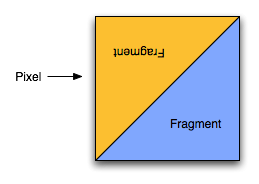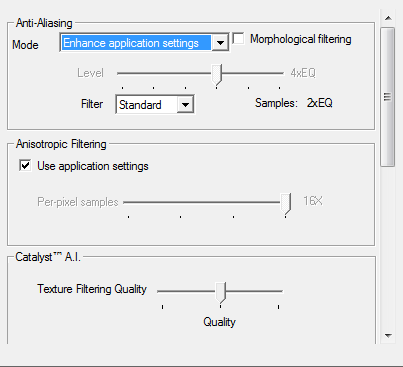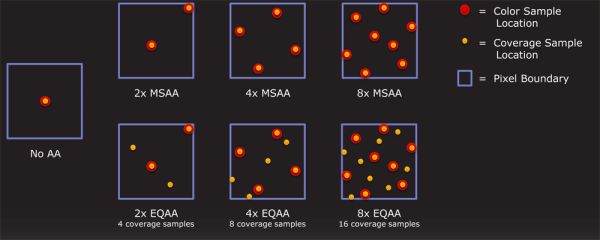AMD's Radeon HD 6970 & Radeon HD 6950: Paving The Future For AMD
by Ryan Smith on December 15, 2010 12:01 AM ESTAnother New Anti-Aliasing Mode: Enhanced Quality AA
With the 6800 series AMD introduced Morphological Anti-Aliasing (MLAA), a low-complexity post-processing anti-aliasing filter. As a post-processing filter it worked with a wide variety of games and APIs, and in most cases the performance overhead was not very severe. However it’s not the only new anti-aliasing mode that AMD has been working on.
New with the 6900 series is a mode AMD is calling Enhanced Quality Anti-Aliasing. If you recall NVIDIA’s Coverage Sample Anti-Aliasing (CSAA) introduced with the GeForce 8800GTX, then all of this should sound quite familiar – in fact it’s basically the same thing.
Under traditional MSAA, for a pixel covered by 2 or more triangles/fragments, 2, 4, or 8 subpixel samples are taken to determine what the final pixel should be. In the process the color of the triangle and the Z/depth of the triangle are both sampled and stored, and at the end of the process the results are blended together to determine the final pixel value. This process works well for resolving aliasing along polygon edges at a fraction of the cost of true super sampling, but it’s still expensive. Collecting and storing the Z and color values requires extra memory to store the values and extra memory bandwidth to work with the values. Ultimately while we need enough samples to determine colors of the involved triangles, we do not always need a great deal of them. With a few color/Z samples we have all of the color data we need in most cases, however the “hard” part of anti-aliasing becomes what the proper blending of color values should be.

1 Pixel Covred by 2 Triangles/Fragments
Thus we have EQAA, a compromise on the idea. Color/Z samples are expensive, but just checking if a triangle covers part of a subpixel is very cheap. If we have enough color/Z samples to get the necessary color information, then just doing additional simple subpixel coverage checks would allow us better determine what percentage of a pixel is covered by a given polygon, which we can then use to blend colors in a more accurate fashion. For example with 4x MSAA we can only determine if a pixel is 0/25/50/75/100 percent covered by a triangle, but with 4x EQAA where we take 4 color samples and then 4 additional coverage-only samples, we can determine blending values down to 0/12/25/37/50/62/75/87/100 percent coverage, the same amount of accuracy as using 8x MSAA. Thus in the right situation we can have quality similar to 8x MSAA for only a little over 4x MSAA’s cost.
In reality of course this doesn’t always work out as well. The best case scenario is that the additional coverage samples are almost as good as having additional color/Z samples, while the worst case scenario is that additional coverage samples are practically worthless. This depends on a game-by-game, if not pixel-by-pixel basis. In practice additional coverage samples are a way to slightly improve MSAA quality for a very, very low cost.
While NVIDIA has had the ability to take separate coverage samples since G80, AMD has not had this ability until now. With the 6900 hardware their ROPs finally gain this ability.
Beyond that, AMD and NVIDIA’s implementations are nearly identical except for the naming convention. Both can take a number of coverage samples independent of the color/Z samples based on the setting used; the only notable difference we’re aware of is that like AMD’s other AA modes, their EQAA mode can be programmed to use a custom sample pattern.
As is the case with NVIDIA’s CSAA, AMD’s EQAA mode is available to DirectX applications or can be forced through the drivers. DirectX applications can set it through the Multisample Quality attribute, which is usually abstracted to list the vendor’s name for the mode in a game’s UI. Otherwise it can be forced via the Catalyst Control Center, either by forcing an AA mode, or as is the case with NVIDIA, enhancing the AA mode by letting the game set the AA mode while the driver overrides the game and specifies different Multisample Quality attribute. Thus the “enhance application settings” AA mode is new to AMD with the 6900 series.

To be honest we’re a bit ruffled by the naming choice. True, NVIDIA did go and have to pick daft names for their CSAA modes (when is 8x not 8 sample MSAA?), but ultimately CSAA and EQAA are virtually identical. NVIDIA has a 4 year lead on AMD here, and we’d just as well use NVIDIA’s naming conventions for consistency. Instead we have the following.
| Coverage Sampling Modes: CSAA vs EQAA | ||||
| NVIDIA |
Mode (Color + Coverage) |
AMD | ||
| 2x | 2+0 | 2x | ||
| N/A | 2+2 | 2xEQ | ||
| 4x | 4+0 | 4x | ||
| 8x | 4+4 | 4xEQ | ||
| 16x | 4+12 | N/A | ||
| 8xQ | 8+0 | 8x | ||
| 16xQ | 8+8 | 8xEQ | ||
| 32x | 8+24 | N/A | ||
AMD ends up having 1 mode NVIDIA doesn’t, 2xEQ, which is 2x MSAA + 2x cover samples; meanwhile NVIDIA has 16x (4x MSAA + 12 cover samples) and 32x (8x MSAA + 24 cover samples). Finally, as we’ll see, just as is the case for NVIDIA additional coverage samples are equally cheap for AMD.











168 Comments
View All Comments
mac2j - Wednesday, December 15, 2010 - link
Um - if you have the money for a 580 ... pick up another $80-100 and get 2 x 6950 - you'll get nearly the best possible performance on the market at a similar cost.Also I agree that Nvidia will push the 580 price down as much as possible... the problem is that if you believe all of the admittedly "unofficial" breakdowns ... it costs Nvidia 1.5-2x as much to make a 580 as it costs AMD to make a 6970.
So its hard to be sure how far Nvidia can push down the price on the 580 before it ceases to become profitable - my guess is they'll focus on making a 565 type card which has almost 570 performance but for a manufacturing cost closer to what a 460 runs them.
fausto412 - Wednesday, December 15, 2010 - link
yeah. AMD let us down on this here product. We see what gtx580 is and what 6970 is...i would say if you planning to spend 500...the gtx580 is worth it.truepurple - Wednesday, December 15, 2010 - link
"support for color correction in linear space"What does that mean?
Ryan Smith - Wednesday, December 15, 2010 - link
There are two common ways to represent color, linear and gamma.Linear: Used for rendering an image. More generally linear has a simple, fixed relationship between X and Y, such that if you drew the relationship it would be a straight line. A linear system is easy to work with because of the simple relationship.
Gamma: Used for final display purposes. It's a non-linear colorspace that was originally used because CRTs are inherently non-linear devices. If you drew out the relationship, it would be a curved line. The 5000 series is unable to apply color correction in linear space and has to apply it in gamma space, which for the purposes of color correction is not as accurate.
IceDread - Wednesday, December 15, 2010 - link
Yet again we do not get to see hd 5970 in crossfire despite it being a single card! Is this an nvidia site?Anyway, for those of you who do want to see those results, here is a link to a professional Swedish site!
http://www.sweclockers.com/recension/13175-amd-rad...
Maybe there is some google translation available or so if you want to understand more than the charts shows.
medi01 - Wednesday, December 15, 2010 - link
Wow, 5970 in crossfire consumes less than 580 in SLI.http://www.sweclockers.com/recension/13175-amd-rad...
ggathagan - Wednesday, December 15, 2010 - link
Absolutely!!!There's no way on God's green earth that Anandtech doesn't currently have a pair of 5970's on hand, so that MUST be the reason.
I'll go talk to Anand and Ryan right now!!!!
Oh, wait, they're on a conference call with Huang Jen-Hsun.....
I'd like to note that I do not believe Anadtech ever did a test of two 5970's, so it's somewhat difficult to supply non-existent into any review.
Ryan did a single card test in November 2009.That is the only review I've found of any 5970's on the site.
vectorm12 - Wednesday, December 15, 2010 - link
I was not aware of the fact that the 32nm process had been canned completely and was still expecting the 6970 to blow the 580 out of the water.Although we can't possibly know and are unlikely to ever find out what cayman at 32nm would have performed like I suspect AMD had to give up a good chunk of performance to fit it on the 389mm^2 40nm die.
This really makes my choice easy as I'll pickup another cheap 5870 and run my system in CF.
I think I'll be able to live with the performance until the refreshed cayman/next gen GPUs are ready for prime time.
Ryan: I'd really like to see what ighashgpu can do with the new 6970 cards though. Although you produce a few GPGPU charts I feel like none of them really represent the real "number-crunching" performance of the 6970/6950.
Ivan has already posted his analysis in his blog and it seems like the change from LWIV5 to LWIV4 made a negligible impact at the most. However I'd really love to see ighashgpu included in future GPU tests to test new GPUs and architectures.
Thanks for the site and keep up the work guys!
slagar - Wednesday, December 15, 2010 - link
Gaming seems to be in the process of bursting its own bubble. Graphics of games isn't keeping up with the hardware (unless you cound gaming on 6 monitors) because most developers are still targeting consoles with much older technology.Consoles won't upgrade for a few more years, and even then, I'm wondering how far we are from "the final console generation". Visual improvements in graphics are becoming quite incremental, so it's harder to "wow" consumers into buying your product, and the costs for developers is increasing, so it's becoming harder for developers to meet these standards. Tools will always improve and make things easier and more streamlined over time I suppose, but still... it's going to be an interesting decade ahead of us :)
darckhart - Wednesday, December 15, 2010 - link
that's not entirely true. the hardware now allows not only insanely high resolutions, but it also lets those of us with more stringent IQ requirements (large custom texture mods, SSAA modes, etc) to run at acceptable framerates at high res in intense action spots.